

Japanese folklore. Japanese folklore answers to the term minkan denshō (民間伝承, "transmissions among the folk"?)

And its the study of folkloristics or minzokugaku (民俗学?). Folklorists also employ the term minzoku shiryō (民俗資料?) Or "folklore material" (民俗資料) to refer to objects and arts they study. Folk religion[edit] Namahage exhibit display A parallel custom is the secretive Akamata-Kuromata(ja) ritual of the Yaeyama Islands, Okinawa which does not allow itself to be photographed.[2][3] Many, though increasingly fewer households maintain a kamidana or a small Shinto altar shelf.[4] The Shinto version of the kitchen god is the Kamado kami (かまど神?)
Yōkai. Ukiyo-e print of yōkai, by Aotoshi Matsui Japanese folklorists and historians use yōkai as "supernatural or unaccountable phenomena to their informants".
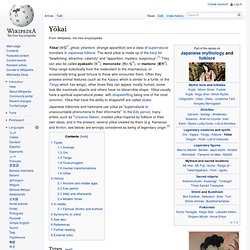
In the Edo period, many artists, such as Toriyama Sekien, created yōkai inspired by folklore or their own ideas, and in the present, several yōkai created by them (e.g. Kameosa and Amikiri, see below) are wrongly considered as being of legendary origin.[2] Types[edit] There are a wide variety of yōkai in Japanese folklore. Animals[edit] Cahiersducelec.univ-st-etienne.fr/files/Documents/cahiers_du_celec_1/clement_levy.pdf. Hannya - 般若 -はんにゃ - Japanese Folklore. « NIN x NIN - 忍者ハットリくん - Ninja Hattori-kun The Movie (Suzuki Masayuki 2004) | Main | Kwaidan - Jiki Ninki (Man-Eating Goblin) » Hannya - 般若 -はんにゃ In Japanese folklore the female demon (oni) Hannya figures prominently.
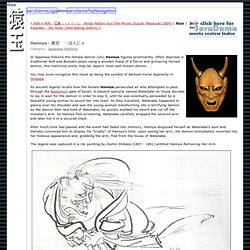
Often depicted in traditional Noh and Bunraku plays using a wooden mask of a fierce and grimacing horned demon, this malicious entity may be Japan's most well-known demon. You may even recognize this mask as being the symbol of darkest moral depravity in Onibaba. An ancient legend recalls how the female Hannya persecuted all who attempted to pass through the Rashomon gate of Kyoto. After much time had passed and the event had faded into memory, Hannya disguised herself as Watanabe's aunt and thereby convinced him to display his "trophy" of Hannya's limb. Maneki-Neko, le chat porte-bonheur. Japanese Folktales. Selected and edited by D.

L. Ashliman © 1998-2008 Contents Return to D. The Two Frogs Once upon a time in the country of Japan there lived two frogs, one of whom made his home in a ditch near the town of Osaka, on the sea coast, while the other dwelt in a clear little stream which ran through the city of Kyoto. So one fine morning in the spring they both set out along the road that led from Kyoto to Osaka, one from one end and the other from the other. They looked at each other for a moment without speaking, and then fell into conversation, explaining the cause of their meeting so far from their homes. "What a pity we are not bigger," said the Osaka frog; "for then we could see both towns from here, and tell if it is worth our while going on. " "Oh, that is easily managed," returned the Kyoto frog. Ancient Tales and Folk-lore of Japan Index. Contents Start Reading Page Index Text [Zipped] This is a memorable collection of historical legends and folktales from Japan.

Nearly all of them are set in a well-defined time and place, instead of 'once upon a time.' Themes include ghosts; unrequited love across social boundaries; Shinto landscape, tree and ocean spirits; and tales driven by Bushido and Buddhist ethics. Not a few of these yarns end up with someone committing Seppuku. Smith does not try to dress up the language or narrative for westerners, or sentimentalize the stories. Each chapter, with one exception, is illustrated by one or more colorful plates done in a typical 19th century Japanese style, all of which are included in this etext.
Title PagePrefaceContentsI. Japanese folklore and mythology. From New World Encyclopedia Japanese folklore are heavily influenced by the two primary religions of Japan, Shinto and Buddhism.
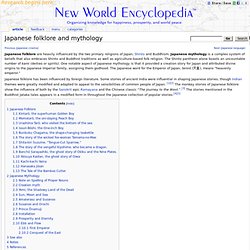
Japanese mythology is a complex system of beliefs that also embraces Shinto and Buddhist traditions as well as agriculture-based folk religion. The Shinto pantheon alone boasts an uncountable number of kami (deities or spirits). One notable aspect of Japanese mythology is that it provided a creation story for Japan and attributed divine origins to the Japanese Imperial family, assigning them godhood. The Japanese word for the Emperor of Japan, tennō (天皇), means "heavenly emperor. " Mythologie Japon: Izanagi Et Izanami. Mythologie du Japon et plus precisement, le couple originel Izanagi et Izanami.
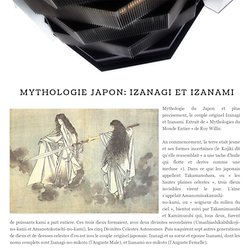
Extrait de « Mythologies du Monde Entier » de Roy Willis. Au commencement, la terre etait jeune et ses formes incertaines (le Kojiki dit qu’elle ressemblait « a une tache d’huile qui flotte et derive comme une meduse »). Dans ce que les japonais appellent Takamanohara, ou « les hautes plaines celestes », trois dieux invisibles virent le jour. 15 créatures incroyables de la mythologie japonaise - Linternaute.com Livres. MYTHOLOGIE JAPONAISE. La mythologie japonaise : un mythe des origines patrimoine de l’humanité ? Ce 11 février, le Japon commémore la création de l’Empire.
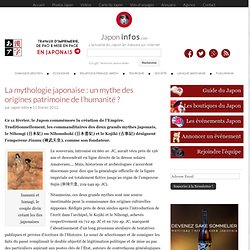
Culture et traditions - Contes / Mythologie. Derniers commentaires Yuki Onna Yuki Onna, la Femme des Neiges, est un yokaï célèbre du folklore japonais, réputé pour sa beauté et sa cruauté.

Personnification de l'hiver, elle apparaît les nuits de tempête pour décider du sort des voyageurs égarés. Kitsune Tout comme le tanuki, le kitsune ou esprit renard, est l'un des yokais les plus célèbres et populaires au japon. Mythologie Ōkami - Expérience-Japon. Mythologie japonaise. A l'origine, la mythologie japonaise est basée sur le Shintô qui est une religion polythéiste tribale importée au Japon pendant la période Yayoi par des émigrants de Corée et de Mongolie.
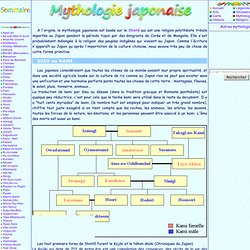
Elle s'est probablement mélangée à la religion des peuples indigènes qui vivaient au Japon. Comme l'écriture n'apparaît au Japon qu'après l'importation de la culture chinoise, nous savons très peu de chose de cette forme primitive. Les japonais considéraient que toutes les choses de ce monde avaient leur propre spiritualité, et dans une société agricole basée sur la culture de riz comme au Japon rien ne peut pas exister sans une unification et une harmonie parfaite parmi toutes les choses de cette terre : montagnes, fleuves, le soleil, pluie, tonnerre, animaux...